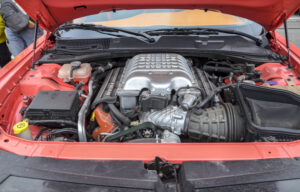There’s very good news for muscle and truck fans: the Hemi V8 is coming back from its government-forced retirement. Credit goes to Donald Trump, who dialed back the punitive fines tied to federal fuel efficiency mandates (CAFE “standards”) that had made it almost impossible for Stellantis—the parent company of Dodge, Ram, and Jeep—to keep the Hemi alive.
When the Hemi was still widely available in models such as the Dodge Charger, Challenger, Ram 1500, and Jeep Grand Cherokee, compliance costs were enormous. And not just CAFE fines. Stellantis was also forced to buy “carbon credits” from Tesla to offset its supposed “carbon footprint.” Because Teslas are classified as “zero emissions” vehicles—they lack tailpipes—the company had surplus credits to sell. Stellantis had no choice but to buy them in order to keep selling vehicles with V8s.
Those costs got passed along to buyers, driving up the price of Hemi-equipped models until they became hard to sell. Stellantis eventually pulled the engine from most of its lineup. Without the Hemi—or even an engine at all in the Charger’s case—sales began to slump. The Hurricane inline-six that replaced the V8 is a capable motor, but it’s not what Dodge and Ram buyers were looking for.
That’s why the Hemi is coming back—and that is the good news.
Even better news: the return won’t come with exorbitant price tags. According to Ram, the 2026 Ram 1500 will offer the Hemi as a stand-alone option across all trims, from the base Tradesman work truck to the top Limited and Longhorn trims. On most models, the option will cost between $1,200 and $2,895; on the higher trims, it will even be a no-cost option. In other words, the V8 won’t be locked behind expensive packages.
Now for the bad news.
The returning Hemi will only be paired with Ram’s “eTorque” mild-hybrid system. Buyers largely ignored this system when it was optional, since it delivers little of real value. eTorque automatically shuts off the V8 whenever possible to reduce gas consumption by a trivial amount and shave a fraction off CO₂ emissions. Owners get the extra cost up front, plus the eventual expense of replacing a hybrid battery.
The difference in fuel economy is negligible. And the difference in CO₂ is almost meaningless, considering that carbon dioxide makes up about 0.04 percent of the atmosphere. Adding or subtracting a fraction of that fraction is like adding or removing a spoonful of sand from a beach.
Worse still, compliance costs haven’t gone away. They’ve only been temporarily eased. Stellantis has already been forced to pay $190.6 million in CAFE fines this year alone, despite the Hemi being nearly absent from its lineup. For the 2025 model year, only the Dodge Durango and the Jeep Wrangler—limited to the $99,995 Rubicon 392 “Final Edition”—still offer the V8.
If political winds shift, the full weight of fines and credit schemes could return. Stellantis could once again be forced to pull the Hemi from the market. The V8’s revival is worth celebrating—but it comes tethered to politics and compliance.
Can Stellantis afford to go through that cycle again?
Editorial Disclaimer
The views and opinions expressed in this blog post are those of the author and do not necessarily reflect the official policy or position of the National Motorists Association. We believe in fostering open dialogue and welcome diverse perspectives on issues affecting motorists. If you would like to submit a response or opposing viewpoint, we encourage you to contribute. Please email us at greg@motorists.org for submission guidelines.







